Shirdi Sai Baba Temple
Shirdi Sai Baba Temple is amongst the most venerated and prestigious temple institutions in India, and the temple is devoted to the Shri Sai Baba's life and teachings, a fakir or a Saint, who is honored and admired by all the religious communities of India. The temple is situated in Shirdi, a small town in the Ahmednagar district of Maharashtra which is very popular in today's time, and Sai Baba devotees from all over the world come to this place.
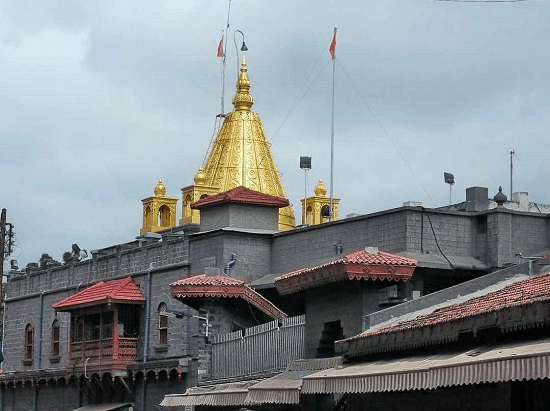
Significance of Shirdi Sai Baba Temple
The Shirdi Sai Baba Temple is very significant, and prestigious, and one can guess it by the fact that the samadhi of Sai Baba can be, and is worshipped by both Hindus and Muslims. Shri Sai Baba, who always opposed the partition of religions, was totally against discrimination on the basis of religion, and the teachings he gave assimilated the best practices of major religions such as Islam and Hinduism. Shri Sai asked his followers to follow the book's teachings, and he, himself Baba admired Bhagawad Gita. Baba's philosophy of "Sabka Malik Ek," which means "God is one," taught and exhorted the same to all his devotees and followers.
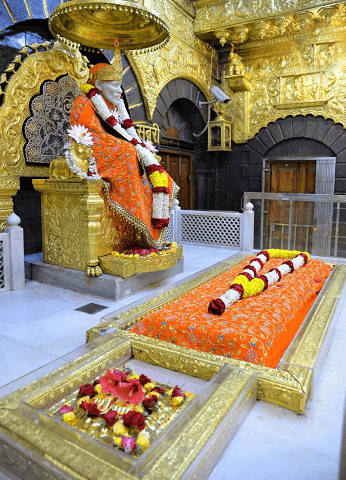
The Sai Baba's eleven assurances assert that he is omnipresent, and Baba will help all the needy and guide them to a healthy and happy life. Anybody who comes to Shirdi will be free from all their worries and sufferings, and it is believed by his devotees that Baba performed miracles to help people.
It is also deemed that he lit the Masjid's lamp without oil. When villagers requested him, he raised the water level of the well during the time of the dry season to drink. A 3-year-old girl fell into the well, and Baba saved her from sinking in the water. The townsman saw her suspended in mid-air and drew her out.
In the masjid, Sai Baba sustained a holy fire which is called 'Dhuni', from which he gave holy ashes 'Udhi' to his visitors before they left. It was believed the ash possessed healing powers, and he, all by himself, carried out the function of a local hakim and treated the ill by applying ashes. Visitors can visit the mosque and feel the piousness themselves.
History of Shirdi Sai Baba Temple
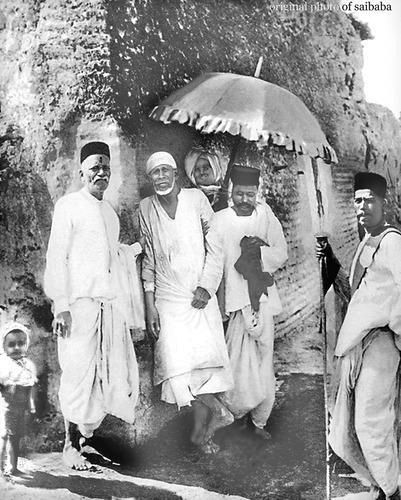
According to history, the temple was erected in the year 1922 to resume the services and teachings of Shri Sai Baba, but, in reality, the real name and born place of Sai Baba is anonymous. At the age of sixteen, he arrived at Shirdi, and upon his arrival, the name "Sai" was given to him by a Mahalsapati, a local priest, and the Mahalsapati identified Baba as a Muslim Saint and addressed him with the words 'Ya Sai', which means 'Welcome Sai!'. The Persian title Sai or Sayi is given to Sufi Saints. In most Indian and the Middle East native tongues, "Baba" means "Grandfather; father; sir; old man". Thusly, Sai Baba symbolizes "saintly father", "holy father," or "poor old man".
The Sai Baba's followers believe that Sai is an acronym of the Sanskrit word "Sakshat Eshwar", where Sakshat means "incarnate," and Eshwar means "God", and in his initial days, Baba stayed under a neem tree at the Khandoba Temple and remained quiet and meditated for a longer period of time. He received various visitors like Appa Jogie and Mahalsapati. He disappeared from Shirdi after staying for three years there. It is deemed that he was with the soldiers of Rani Lakshmibai of Jhansi at the time of the revolt of 1857, and it is also believed that in the year 1858, Sai Baba returned to Shirdi.
Baba's manner was taciturn, and he repeatedly meditated for long durations. Later, Baba was convinced to take up accommodation in an old masjid, where he lived a lonely life. Later the mosque was named 'Dwarkamai', where many visitors came to meet Sai Baba, and he gave them holy ash possessing 'udi'.
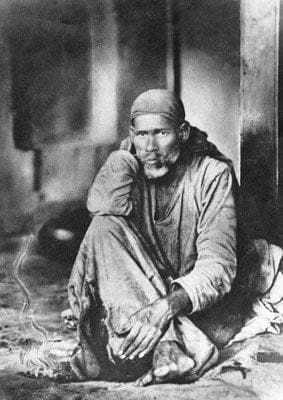
Sai Baba believed that goodwill and charity is the greatest way to win the grace of God. He lived a simple life and inspired everyone with his concept of sharing. He points up that people should be welcomed in their homes and greeted with respect. He asked his followers to offer clothes, water, food, money, and a place to stay charitably to the poor and needy.
The philosophy and life history of Sai Baba are recorded in the manuscript "Sai Satcharitra". This manuscript is the work of a passionate follower of Baba, Hemadpant. It is deemed that Baba himself blessed Sai Satcharitra and wanted his philosophies and teachings to be disseminated around by means of books. In Shirdi, Shri Saibaba Sansthan is the administrative and governing body of the Saibaba's Samadhi Temple and every temple that is in this premises. The Saibaba Sansthan Trust also looks for and works for the Shirdi village's general development.
Poojas and Sevas Performed at Shirdi Sai Baba Temple
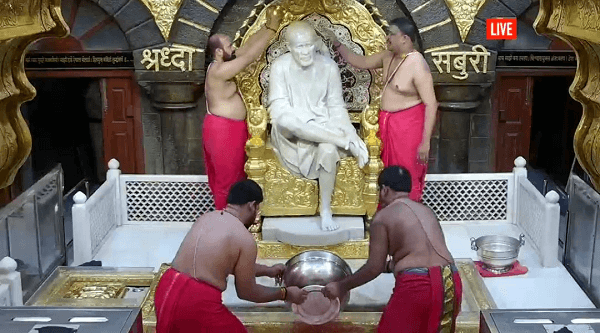
- Sai Satcharitra Parayan: Once every month, the reading of the book Sai Satcharitra takes place in the Shirdi Sai Baba Temple Complex, and during this Satcharitra, at 8 Am the morning, the reading of the book starts, and generally, the reading completes before each of two, the Dhoop or the Shej Aarti.
- Sai Satya Vrata Pooja: The special Pooja is done in the Shirdi Sai Baba Temple Complex at no cost once in three months on the full moon day (Purnima), where 108 couples participate in the Pooja at once. As per an incident in Sri Sai Satcharitra, Bhimaji Patil, who was suffering from Tuberculosis, was cured by Sai Baba. After getting cured, he began a ritual of worshipping Sai Baba as Satyanarayana. The worship has been named again as Sai Satya Vrata Pooja.
- Bhupali: The first in a series of Bhajans and Aartis are sung to worship Sai Baba; the Bhupali Aarti is done at 4:15 Am daily. The Bhupali Aarti comprises four songs, and the duration is 10-15 minutes.
- Kakad Aarti: The Kakad Aarti is the Morning Aarti and is presented to Baba between 4:30 AM to 5:00 PM., and a piece of cloth is immersed in ghee and then ignited to perform the Kakad Aarti. This Aarti is done to wake up Baba and receive his blessings and grace.
- Mangal Snaan: At 5:05 in the morning, Shri Saibaba is bathed in hallowed water in the Samadhi Temple.
- Satyanarayana Pooja: Satyanarayana Pooja is devoted to the male deity Vishnu and is performed between 7 am to 12 pm, and Devotees can also perform this Pooja by paying ceremonial charges at the Pooja counter.
- Madhyan Aarti: Many songs are sung to worship Sai Baba and his followers during this Aarti, and this Aarti is performed in the afternoon from 12:00 pm to 12:30 pm
- Dhoop Aarti: The Dhoop Aarti is done for 20 minutes at sundown daily. The Aarti is split up into eight different song series, each praising Sai Baba and his goodness.
- Shej Aarti: Shej Aarti is the Night Aarti performed between 10:30 pm to 10:50 pm for 20 minutes daily. Following Aarti, a shawl is muffled around the Saibaba's idol, and around his neck Rudraksha, mala, is hanged. The glass of water is put near Baba's idol, and the mosquito net is lowered.
- "Palki" procession every Thursday is performed at around 9:15 pm, from Samadhi Mandir to Dwarkamai, then led to Chawri.
- The Darshan is stopped when the aarti is being performed.
Every day special abhishekams are performed in two batches, and a third batch is conducted in case there is a large crowd. The timings of the Abhishek batch are given below:
- Batch one: 7 am to 8 pm
- Batch two: 9 pm to 10 pm
- Batch three: 11 am to 12 pm
The Satyanarayana Pooja is conducted in three batches daily, and two more batches may be arranged in the condition of a heavy crowd. The pooja timings are given below:
- Batch one: 7 am to 8 pm
- Batch two: 9 pm to 10 pm
- Batch three: 11 am to 12 pm
Devotees who desire to feed the poor and needy can arrange for the process by paying an amount at the Account office or "Prasadalaya".
Shirdi Sai Baba Temple Timings
The opening hours of the Temple are 4'o clock in the morning, and it closes at 11'o clock in the evening. The temple also conducts several rituals during this time. The devotees can participate in these rituals like poojas and aarti.
The Shirdi Sai Baba Temple's timings are as follows:
- Temple opens at 4:00 am
- Bhupali timings are 4:15 am
- Kakad Aarti starts at 5:00 am
- Bhajan timings are 5:05 am
- Mangal snan is performed at 5:05 am
- Aarti timings are 5:35 am
- Darshan starts at 5:40 am
- Dhuni Pooja is performed at 11:30 am
- Midday Aarti starts at 12:00 pm
- Pothi timings are 4:00 pm
- Dhoop Aarti starts at sundown
- Devotional songs are performed at 8:30 pm
- Shej Aarti starts at 10:30 pm
- The Temple closes at 11:00 pm
Festivals celebrated at Shirdi Sai Baba Temple
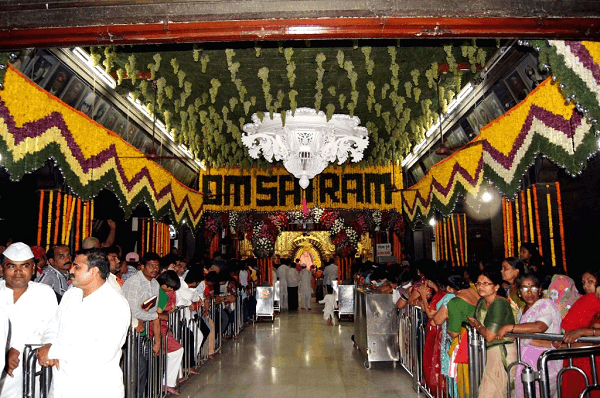
Festivals that are celebrated at the temple are described below:
- Ram Navami: Ram Navami is celebrated at the temple in March or April, and this festival is celebrated with great enthusiasm and elation. As per the story, in the year 1897, Gopalrao Gund proposed to celebrate 'Urus', (a Muslim festival to venerate a saint) devoted to Sai Baba, thanking him for his grace and granting him the wish of a child after so many years. Baba assented but asked Gopalrao to celebrate it on Ram Navami. For that reason, on this day, both Muslims and Hindus celebrate the festival cheerfully together, resulting in social peace and the absence of conflict amongst the communities, and therefore, the Dwarkamai's flags are replaced on Ram Navami along with the sack of wheat kept there.
- Guru Purnima: The Guru Purnima, the full moon day of July month, is celebrated with great respect and devotion in Shirdi. The festival is devoted to Guru, and special poojas are presented in front of Baba to honor him and seek his grace and blessings. In honor of Ved Vyas, who wrote the epic Mahabharata, 'Vyasa Pooja' is held this day.
- Vijayadashami: It is said that Vijayadashami was also the day when Sai Baba left the earthly life for his divine abode. The day is also called 'Shri Sai Punyathithi', and 'Brahman Bhojan' is organized with 'Guru Dakshina' (Donation to Guru) during this festival. Devotees from nationwide visit Shirdi to pay reverence to Shri Sai Baba.
Temples in Shirdi
There are some temples near the Shirdi Sai Baba Temple Complex that are mentioned below:
- Gurusthan: Gurusthan is located under a neem tree and is a place where Sai Baba mostly spent his time during his early stay in Shirdi. Sai Baba said, his 'Guru' is inhumed beneath the tree, and no disturbance should be made to him, and by the side of the tree, one can see a Shivlinga, a pair of marble padukas on a plinth, and Baba's idol at the place.
- Khandoba Temple: Khandoba Temple is the place where Sai Baba was named "Sai" upon coming to the Shirdi. A large banyan tree is there at the temple's entrance that is mentioned in the 'Shri Sai Satcharitra' as a site where the bull carriage comes to a standstill. It is now memorialized with a small temple and 'padukas' at its base.
- Samadhi Mandir: Initially, Samadhi Mandir was erected in the devotion of the male deity Krishna. It is said that Sai Baba suggested that Gopalrao Booty build a shrine so that he could fulfill the people's needs. With the approval of Sai Baba, in 1915, construction work started on the temple. When Sai Baba fell ill, he told his followers to move him to the temple, and on October 15, 1918, he breathed his last, and after he left his mortal life, he was buried in the temple, and his statue was positioned over it.
- Dwarkamai: The small masjid where Sai Baba abided has become the focal point in Shirdi as it gives a glance at the religious life he leads. Visitors can visit the "Perpetual Fire" or the "Dhuni" and see the Kolamba, the Nimbhar, Sai teeth, cooking pot, the sack of wheat, and many other relics that possess legends and personal significance related to them.
- Chavadi: It is the place where during Baba's last decades of his life, he slept on alternate days there. It played a significant role at the start of the ceremonial worship of Baba. The ritual of offering Shej (night) Aarti to Baba began on his arrival from the masjid once he started sleeping at Chavadi. Later, Kakad Aarti, or morning aarti, was offered to Baba when he woke up there.
- The Lendi Gardens: Sai Baba often visited this garden complex to do meditation and think about worldly matters. People can visit the Nanda Deep- the continually ignited Deep kept betwixt two trees here.
- Shani Shinganapur Temple: Shani Shinganapur Temple is positioned in the village of Shinganapur which is situated in the Ahmednagar. This temple is dedicated to Lord Shani, as the name suggests, and Lord Shani is the personification of Saturn as per Indian mythology. Devotees from all over the world pay respect to the idol of Lord Shani made of black stone and placed in the temple. One very interesting fact about this village is that not even a single house in the village has doors, and it is because it is believed in this village Lord Shani is guarding all the homes of the village.
- Maruti Mandir: Visitors who come to visit Shirdi Sai Baba Temple never go back without visiting Maruti Mandir because of its popularity among devotees, and it is positioned only 1 KM away from the Shirdi Sai Baba Temple. Lord Hanuman is worshipped here as Maruti is another popular name for him, and a huge life-size black idol of Shri Hanuman is present in this temple.
- Mahalaxmi Temple: Mahalaxmi Temple have a huge-size idol of Goddess Laxmi, and this temple is very popular among the devotees of Goddess Laxmi Mata. Goddess Laxmi is popularly known as the Goddess of wealth, and along with her idol, Shivlinga and Navagraha idols are present in the temple.
Ways to reach Shirdi Sai Baba Temple
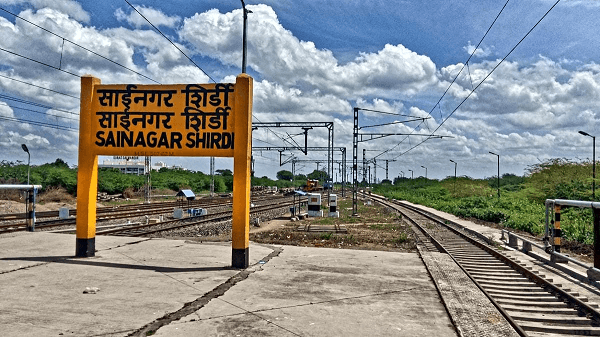
- By Road: From the main cities in Maharashtra as well as from the neighboring states of Karnataka, Tamil Nadu, Andhra Pradesh, and Telangana, state transport buses are accessible.
- By Train: "Sainagar Shirdi" is the name of the station at Shirdi, which began its operations in March 2009. Regular trains are accessible to the city from Mumbai, Secunderabad, Mysore, Chennai, and Visakhapatnam. Some other main railway stations placed nearby are Kopergaon (15km), Ahmednagar (83 km), Nashik (119 km), and Manmad (87km). Regular buses are accessible to Shirdi from these cities.
- By Air: The nearest airport to Shirdi is Aurangabad, located at a distance of 144 km, and from Aurangabad to Shirdi, bus services are easily accessible.
Accommodation at Shirdi
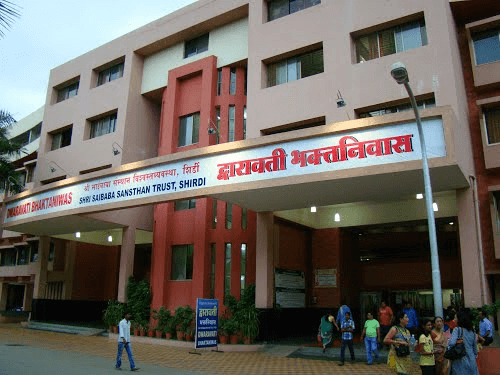
Accommodation at official rates is available at Shirdi. The Shirdi Sansthan Trust Reception Centre is located nearby State Transport Bus Stand, where proper guidance to the arriving pilgrims is provided, and rooms are allotted., and also, locker facilities are made available for luggage storage.
Dwarawati, New Niwas, and Sai Ashram are the three major accommodations run by the Shirdi trust, and these are some of the good options available. Large normal rooms, Air- conditioned rooms, and dormitories are available for the visitors. Online booking services for the accommodation can be done by visiting the official website of the temple, and beside this, many privately operated lodges and hotels are also available as a choice for staying purposes.
Places to eat in Shirdi
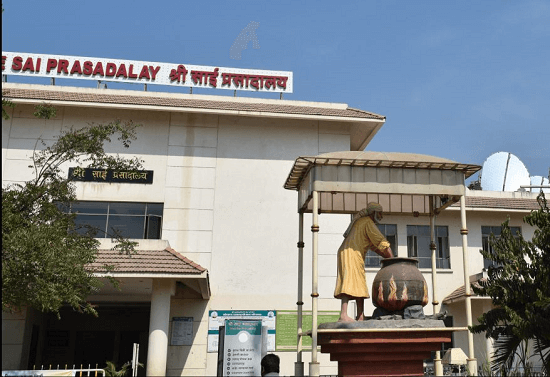
Shirdi Sai Baba Sansthan Trust runs a "Prasadalaya" and a tea canteen. Pilgrims can have meals and tea between 10 am to 10 pm at subsidized rates.
Many small restaurants serving vegetarian meals nearby the temple premises can be visited. Smoking and alcohol are banned.
Dress code at Shirdi Sai Baba Temple
Inside the Shirdi Sai Baba Temple Complex, there are no strict rules for attires applicable. Though, it is recommended to wear decent attires inside the temple and mosque premises.
|









 For Videos Join Our Youtube Channel: Join Now
For Videos Join Our Youtube Channel: Join Now










